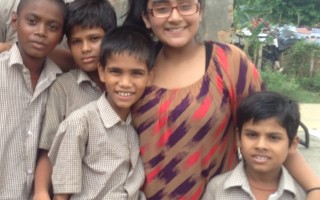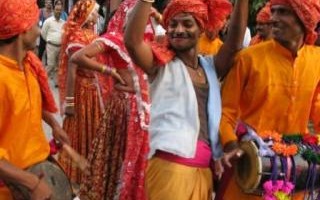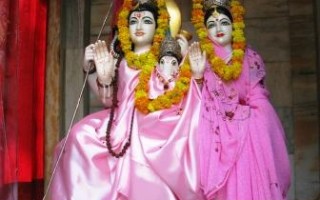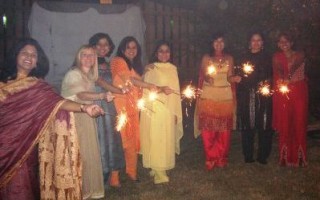
Teaching is one of my passions. My name is Manika Bhatia. I am a 12 year old girl, studying in 7th grade at North Gwinnett middle school in suburbs of Atlanta. I enjoy playing basketball, swimming, volunteering with kids, and spending time with friends and family. When I grow up, I would like to be a […]

The festival of Holi is celebrated once a year during spring time in India. It has a strong mythological, cultural and social significance. It is a day when people of all ages, religions and backgrounds come together to play with dry and wet colors, water balloons, and much more. Everyone would be outdoors, laughing, giggling, soaking in bright colors, leaving […]

Traveling abroad to a foreign country where you don’t know the language or the culture can be quite daunting. You are probably going to ask your friends or read a few travel books before you hop on the plane. But no matter where you go, here are five tips I recommend you follow and keep […]

I grew up as a Catholic in a country where less than 1% of the population is Christian. In the city of Chandigarh in northern India, ours was among the handful of Christian families. Even though Christmas was a big deal for us, it wasn’t as festive around as it is here in the western […]

Taste of Atlanta got a special treat from India today. As part of the “Spice of Life” segment at the “Inside the Food Studio” stage, I talked about different spices and their benefits, and share with participants a very special recipe that many westerners are unfamiliar with.

We tend to undermine the role of cultures in building stronger economies. But the fact is culture leads to tourism, tourism brings in jobs, and jobs build economies. Even the idea of foreign currencies and trading them through brokers like Libertex (look at the Libertex Gebühren here) have the ability to heighten and increase the […]

Curry Masala is the only Indian restaurant in Rapid City. “Someone has to serve the vegans, vegetarians and gluten and dairy allergic people” says Al, who is doing the community a service as well as running a successful business in downtown Rapid City. Many of the local patrons are searching for options that are able […]

The Golden Temple in Amritsar is one of the most spiritual places in India. The temple is a Sikh temple (aka gurduwara). It was constructed in 1604. Made entirely of gold, the temple is simply spectacular in its architecture and beauty teaching lesson of egalitarianism and humility. Even though I grew up in north India, […]

New Delhi, the capital of India is perhaps the only city in the world where a vast number of different religions coexist with much harmony. The population of India is majority Hindu, but also includes a good number of Muslims, Sikhs, Christians, Buddhists, Jains, Jews and Zoroastrians. If you want to visit all their places […]

The past week has been rather interesting and insightful. I have been in India, acting as a host and guide to my dear friend, Gina. This is her first time visiting India, even Asia. She is originally from US but currently living in Spain. The first day we took a drive in Delhi, Gina pointed […]

Growing up in India, Diwali was a huge affair. It is a festival celebrated by all of India (Hindu or not), sort of like New Year’s. Known as the festival of lights, the victory of good over evil, homecoming of Lord Rama and welcoming Goddess Lakshmi, Diwali is the biggest festival in India. The scene […]
The second Emory conference on Religion, conflict, and Peacebuilding 2011 took place this past weekend. Yesterday, Dr. Kiran Bedi gave a public talk on “Contemporary Issues and Practical Solutions” that included her movement against anti-corruption in India. Her fame started when she issued a parking ticket to the Prime Minister of India (Mrs Indira Gandhi) and […]

Have a lot of leftover Easter eggs and don’t know what to do with them? Well, there is good news for you! You can use your hard boiled eggs in lots of international recipes that your family won’t get bored with. Some of these are even good for entertaining. So take a stroll around the […]
Chicken curry is a popular dish in India, served at every household and restaurant. The preparation however varies from region to region. The Karwar version of the chicken curry includes coconut and a concoction of spices. These are not your typical out of the box seasoning and a visit to an ethnic grocery store would […]
Karwar is a small town on the western coast of India, just south of Goa. It was an ancient site of sea trade visited by the Arabs, Dutch, Portuguese, French and later the British. Karwar is still known for its pristine beaches and a bustling seaport. Although a lot of information can be found on […]
In spring of 2000, I was enrolled in a Leadership and Group Dynamic course while pursuing my Bachelors degree at Georgia State University. On the last day of class, we were asked to bring a dish each so we can have a potluck party and celebrate the end of the course. It was also a […]
In these financially demanding times, it can sometimes get difficult to pay for the services we normally would. Moreover, you want to compensate the service provider by tipping him/ her adequately. All of these costs add up quickly. I want to share a story with you on tipping when on budget. When my grandparents first […]
In my attempt to stimulate your global palette, this is the second post in a series of Fusion cooking. These are just some tips that will veer your creativity in the right direction. Keep in mind, there are unlimited possibilities in terms of what you can do yourself! Trick #2 : Play with spices […]
I attended high school in a small town in northern India. It was an all-girls Catholic Convent school, right across the street from where I lived. Our school was considered to produce polished, well-spoken, and smart girls who were quite successful in whatever path they chose after graduation. From sixth grade until now, I have […]
